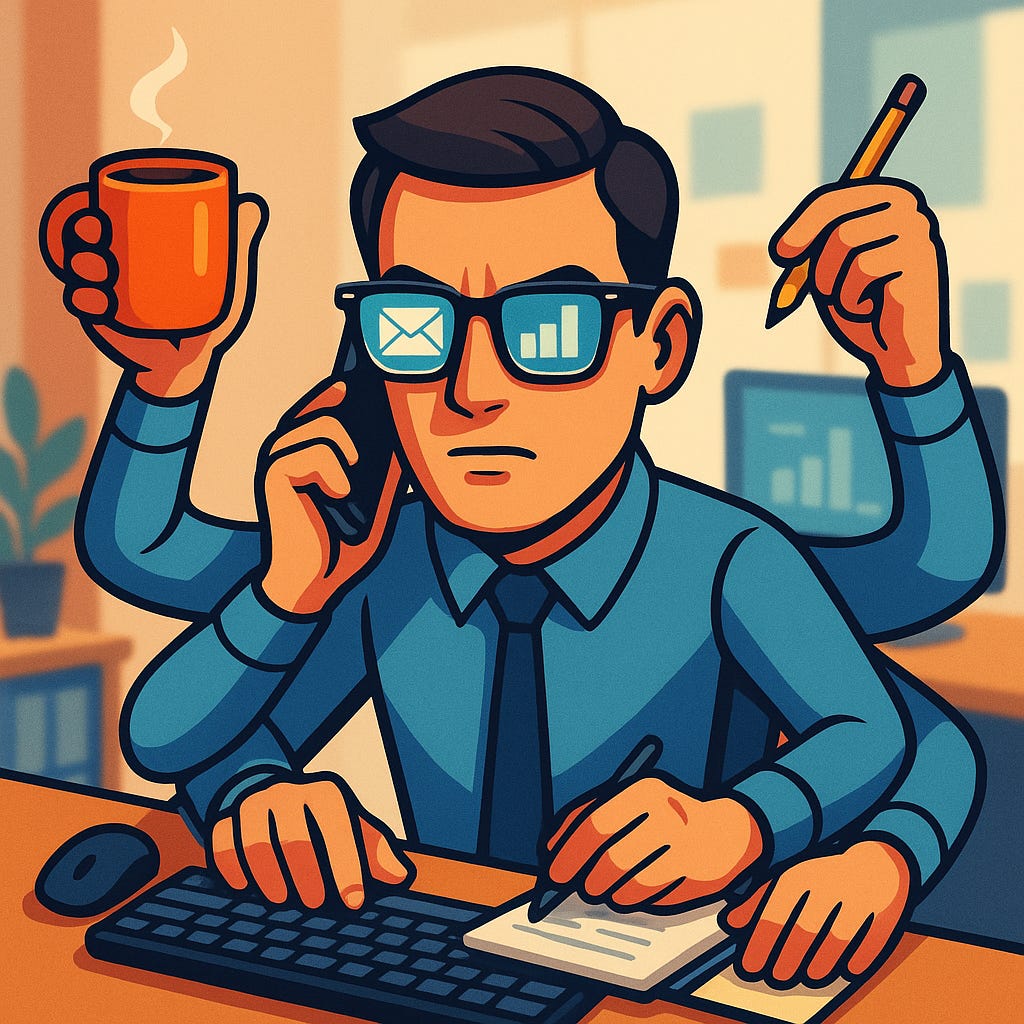The Future of Multitasking
The Changing Nature of Multitasking
In everyday life, multitasking has never really meant doing multiple things at once. It’s about switching attention quickly from one activity to another. We often layer office work, conversations, and planning on top of each other. For example, updating a spreadsheet while in a meeting or firing off a text during a Zoom call. It feels efficient, but brain science says otherwise. Our working memory and attention are limited, and every switch comes with a cost: reduced accuracy, slower progress, and rising stress.
In the modern digital office, the word “multitasking” takes on a new meaning. Today it describes a blur of emails, spreadsheets, calls, texts, Zooms, and errands—usually accompanied by various alerts and a creeping sense of overload. Generative AIs, agents, vibe coding and AI app’s are already layering on top of this daily grind, reshaping how we handle the flow of tasks.
But twenty years from now (viz. 2045), multitasking won’t mean stretching our attention thinner. It will mean amplifying ourselves wider. Imagine AI glasses that guide your focus, digital jewelry or clothing that extends your senses, and personal agents that anticipate needs before you even articulate them. Add to that the rise of superintelligent systems, and the way we work, live, and carry out our daily activities will be redefined.
Multitasking will no longer be about managing distractions—it will be about extending human capability.
AI Glasses: The Future Computing and Multitasking Platform
Meta recently introduced its latest Ray-Ban AI glasses, the “Meta Ray-Ban Display”, at Meta Connect. On September 30, 2025, they went on sale in the U.S. starting at about $799 (including the bundled Neural Band).
In twenty years, smart glasses will be as common as smartphones are today. For many people, instead of glancing at a laptop or phone, information will appear seamlessly in their field of view. Need a summary of the meeting you just walked into? It’s hovering at the corner of your vision. Looking at a product on a shelf? Your AI overlays its price history, reviews, and whether your company already has a supplier deal.
Glasses won’t just show you data—they’ll coordinate with your AI agents in the background, constantly preparing, filtering, and anticipating.
Ubiquitous Agents: Expanding and Enhancing Multitasking
AI assistants are already on the rise. Over the next 20 years, they are likely to evolve into autonomous agents that function as parallel processors for everyday life. While one task is in focus, other agents could handle activities such as monitoring market signals, preparing creative options for upcoming projects, or drafting documents and negotiating small contracts. Instead of manually switching between application tabs or meetings, you’ll orchestrate a small swarm of AI extensions, each trained on your preferences, history, and style.
Super Intelligent AI: From Multitasking to Multipresence
The real breakthrough will come with general AI or super intelligence. Once machines can fluidly handle the breadth and complexity of human reasoning, multitasking won’t be about “doing many things at once” at all.
You’ll have multipresence—the ability to be in many contexts at once. Picture this:
Your digital twin attends a vendor presentation that turns into a negotiation.
Another agent runs a customer onboarding session.
A third prepares your quarterly review deck.
Meanwhile, you’re fully immersed in designing your next big product.
Each agent instance is parameterized to align with defined objectives, constraints, and interaction patterns—functioning not as generic software, but as a persistent extension of your own decision framework.
From Juggling to Orchestrating
Multitasking is shifting from the exhausting act of juggling to the intentional art of curation. Instead of splitting attention across competing demands, the future is about directing focus to what truly requires your presence, while intelligent systems, autonomous agents, and parallel processes handle the background tasks. The work no longer piles on your desk—it flows through an orchestrated system where your role is to guide priorities and make judgment calls. In this model, productivity isn’t about doing everything at once; it’s about designing the stream of work so that your energy is spent where it has the greatest impact, while the rest unfolds seamlessly in parallel.
Conclusion
By 2045, autonomous agents will operate as trusted extensions of human intent—aligned with individual values, capable of continuous learning, and embedded across daily workflows. Rather than tools that require constant input, they will function as parallel systems that anticipate needs, negotiate outcomes, and optimize decisions. The shift will mark not just an evolution in software, but a redefinition of what it means to extend human capability through technology.


